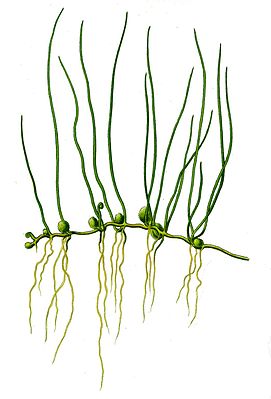Common pill fern
| Common pill fern | ||||||||||||
|---|---|---|---|---|---|---|---|---|---|---|---|---|

Ordinary pill fern, illustration from Thomé: Flora of Germany, Austria and Switzerland |
||||||||||||
| Systematics | ||||||||||||
|
||||||||||||
| Scientific name | ||||||||||||
| Pilularia globulifera | ||||||||||||
| L. |
The common pill fern ( Pilularia globulifera ), also called ball pill fern, is a species from the genus of pill ferns and belongs to the family of the clover family ( Marsileaceae ).
description
The common pill fern is a perennial plant . The creeping stem axis is about 1.5 millimeters thick. There are one to five leaves at each node. The leaves are upright, light to dark green and rush-like, but curled up in a spiral when young. The leaves are 3 to 10 centimeters long and only 1 millimeter thick. The sporocarpies are found at the base of the leaves; they are spherical with a diameter of about 3 millimeters and stand on a short, upright stem. They are initially yellow-green, later black-brown and quadruple. Each subject contains a sorus. The spore maturity is reached between July and August.
The number of chromosomes is 2n = 26.
ecology
The sporocarpies of the common pill fern are only formed in autumn and only on sites that have fallen dry. However, the plant often remains sterile. Its optimal development is quickly completed in autumn, then through vegetative propagation , when it can form closed lawns of up to 1 square meter; but often it stays out for years.
Occurrence
The distribution area of the common pill fern is limited to Europe; It focuses on the North Sea and ranges from Portugal and Ireland to France and Italy to Scandinavia , Poland and south-west Russia . The common pill fern occurs mainly in the lower elevations. In Central Europe , the pill fern is a critically endangered species.
The common pill fern thrives on lime-poor, humus-rich and sandy mud soils in occasionally flooded locations such as lake banks, pond edges, ditches and peat cuttings , also on heather soils , on wet corn fields and in ponds . He is a Kennart of Pilularietum globuliferae (Hydrocotylo-Baldellion Association).
Endangerment and population development in Germany
The pill fern is considered to be endangered across Europe with a sharp decline. In Switzerland all natural occurrences are extinct. In Germany the pill fern is classified as "endangered".
The cause of the risk is, among other things, the intensification of pond management , with the associated pond expansion, the high stock of fish, etc. Regular control of stocks and extensive pond management promote the preservation of this species and enable conservation measures.
literature
- Josef Dostál: Family Marsileaceae fern family. In Gustav Hegi : Illustrated Flora of Central Europe. Volume I, Part 1, pages 285-289. 3rd edition, Verlag Paul Parey, Berlin, Hamburg, 1984. ISBN 3-489-50020-2
- Erich Oberdorfer : Plant-sociological excursion flora for Germany and neighboring areas. Publishing house Eugen Ulmer, Stuttgart. 8th edition, 2001. Page 87. ISBN 3-8001-3131-5
Individual evidence
- ^ Oskar Sebald, Siegmund Seybold, Georg Philippi (ed.): The fern and flowering plants of Baden-Württemberg . 2nd, supplemented edition. tape 1 : General Part, Special Part (Pteridophyta, Spermatophyta): Lycopodiaceae to Plumbaginaceae . Eugen Ulmer, Stuttgart (Hohenheim) 1993, ISBN 3-8001-3322-9 .
- ^ W. Subal: Gewöhnlicher Pillenfarn, Pilularia globulifera L. Bavarian State Office for the Environment, February 2008, accessed on March 15, 2018 .
Web links
- Common pill fern. In: FloraWeb.de.
- Common pill fern . In: BiolFlor, the database of biological-ecological characteristics of the flora of Germany.
- Profile and distribution map for Bavaria . In: Botanical Information Hub of Bavaria .
- Pilularia globulifera L., map for distribution in Switzerland In: Info Flora , the national data and information center for Swiss flora .
- Distribution in the Netherlands [1] (Dutch)
- Distribution map in the northern hemisphere linnaeus.nrm.se
- Thomas Meyer: Data sheet with identification key and photos at Flora-de: Flora von Deutschland (old name of the website: Flowers in Swabia )



